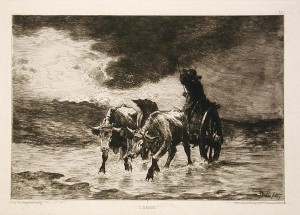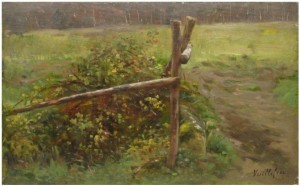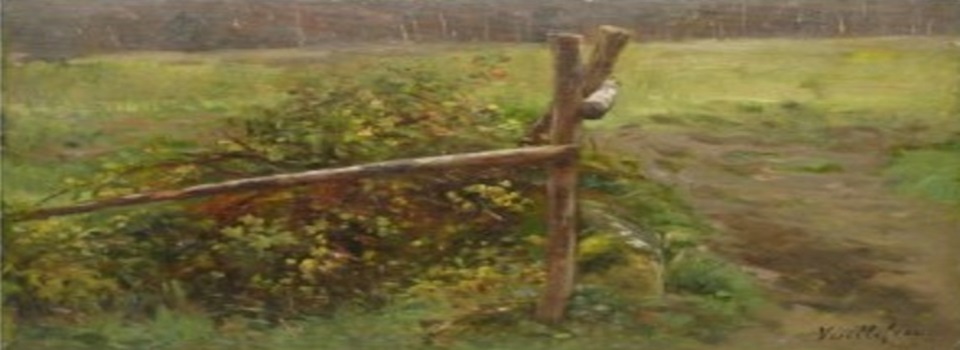Félix - de Vuillefroy Cassini was a brilliant personality. Both painter , engraver, an entomologist , he was a founder of the Society of French Artists. He was the son of Senator Charles- Amédée de Vuillefroy (1810-1878) and Felicie Feuillade (1822-1843), died when he was only two years. His biographers in the art press of the late nineteenth century love to portray an artist who renounced the annals of the State Council for the adventure of being an artist, bohemian.
Indeed, after a childhood spent between Paris and the family castle of Fillerval (heritage of Cassini, the grandmother of the artist was the last descendant), Felix followed the family tradition and began legal studies. Once a law graduates, he prepared the contest and entered the State Council as an auditor second class June 25, 1864, at the Legislation section, Justice and Foreign Affairs. Thus began his short career at the State Council: in 1865 it passed to the Finance Section, Agriculture and Commerce, and December 31, 1866, he was promoted to first-class listener. Short career because he felt that "the dust folders" of the State Council was not made for him, he was more attracted to the study of natural sciences at the example of his ancestors Cassini, and in 1865 he made a trip to Spain with the Entomological Society of France. The young man crossed Spain, discovered the landscapes that will mark some of his work, it is also during this expedition was listed insect "Nebria Vuillefroyi," named in honor of the young entomologist.

Herd of cows in the mountains of Drill, 1889 , whereabouts unknown
Along with this passion for science was born an interest in painting, and especially for the Barbizon School. The story of the young Vuillefroy seeking ferns or insects, meeting by chance painters painting the motif in the forest of Barbizon is often told not without romance. But the fact is that frequented the artists living in the forest of Fontainebleau, including Jean-François Millet and Felix Ziem, the latter shouldered in his debut at the Salon. Vuillefroy then decided to abandon the State Council in June 1869 to go against his father's will, and become a painter. He had entered initially in the Swiss Academy and then in the studio of Ernest Hebert was to be quickly entrusted to Léon Bonnat due to the departure of Hébert to Rome. Felix Vuillefroy exhibited for the first time at the Salon in 1867, was the official beginning of a long career that did not end until 1913, when his last show.

The storm , 1877 etching, private collection.
Animal painter, his paintings are mainly devoted the grounds of the cow. Although he painted other subjects, this issue was very important and makes sense in the political context of the Third Republic. Indeed, the young republic, concerned about stability, encouraged the painting "terroir", exalting the feeling of national cohesion and sustainability. The 1870-1890 period was then the moment of fulfillment of a painting dedicated to cattle where the most famous actors alongside Vuillefroy were Rosa Bonheur, Emile van Marcke or Barillot Leon.
The Salon of 1870 was the occasion for a first Vuillefroy medal and a first purchase by the state of his painting "Morning in Bas-Breau." Thereafter the State buy her other paintings in 1879 and 1880 Salons particular. The year 1880 was also for him that his appointment as a Knight of the Legion of Honor. His long career was marked by his involvement in the organization of the Show: founding member and secretary of the Society of French Artists in 1881 and member of the jury of the Painting section. Vuillefroy also practiced engraving etching it particularly illustrated books of his friend Felix Thiollier.
From the late 1890s the health of Felix Vuillefroy deteriorates and its involvement in the artistic life of the time decreases, absent from the Salon between 1899 and 1910 he sold his studio at Drouot in 1907. The end of life of the painter remains poorly documented but the correspondence he had with his friend Paul Nadar brings us information. It seems that the First World War ruined Vuillefroy, the economy has deteriorated, and fortune seemed mainly based on property whose tenants were no longer obliged to pay the rent due to the moratorium. In the last years of his life he left his Paris studio of 3 Andrieux street to withdraw at Maisons-Laffitte , where he died in 1916. His grave is currently still not located.
Felix Vuillefroy in museum collections:
- Aix-les-Bains, Musée Faure
- Amiens, Musée de Picardie
- Bagnères-de-Bigorre, Musée des Beaux-Arts Salies
- Colmar, Musée d’Unterlinden
- Cusset, Musée de la Tour-Prisonnière et Souterrains
- Dunkerque, Musée des Beaux-Arts
- Le Mans, Musée de Tessé
- Lyon, Musée des Beaux-Arts
- Paris, Musée d’Orsay
- Paris, Ecole nationale supérieure des Beaux-Arts
- Paris, Bibliothèque Nationale de France
- Reims, Musée des Beaux-Arts
- Rouen, Musée des Beaux-Arts
- Saint-Etienne, Musée d’Art Moderne
- Soissons, Musée des Beaux-Arts
- Baltimore, Museum of Art
- Faenza, Pinacoteca Comunale
- Londres, British Museum
- San Francisco, Fine Arts Museums
- Santiago de Chile, Museo de Artes Decorativas

The barrier , about 1883 , private collection.
